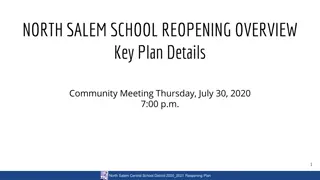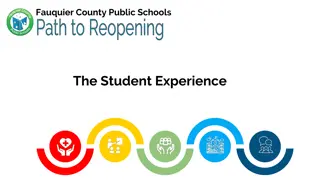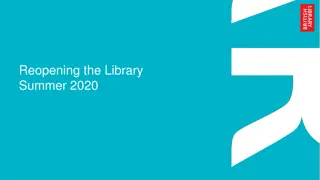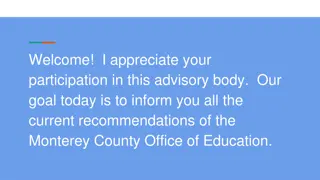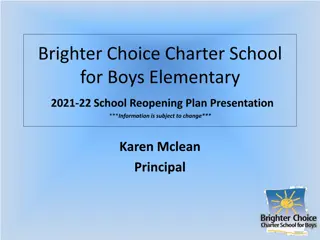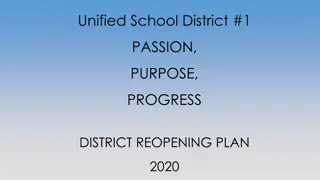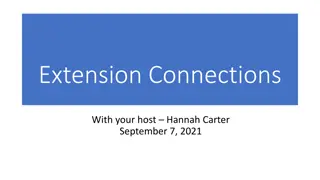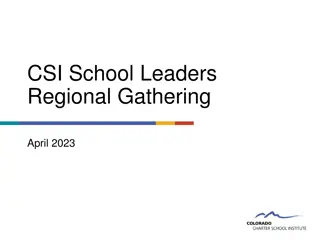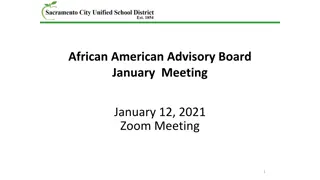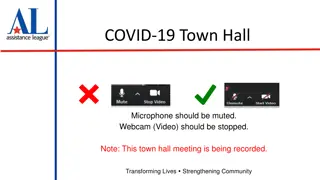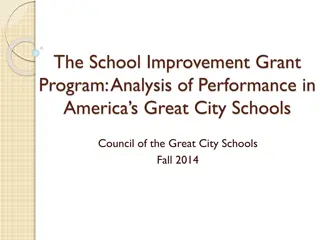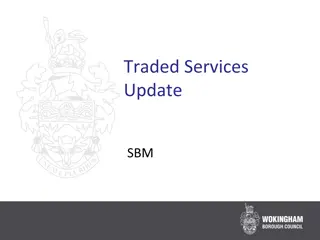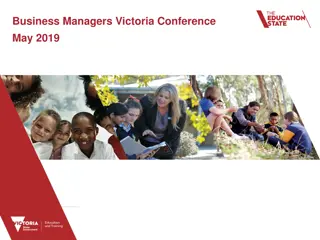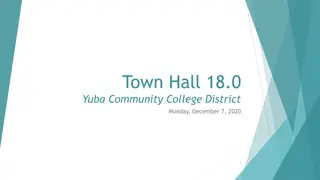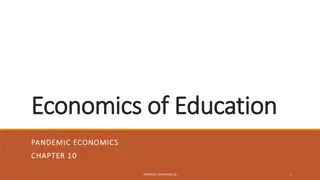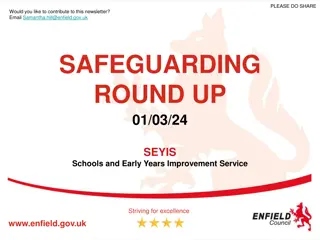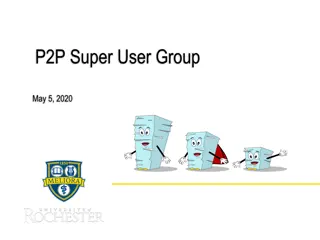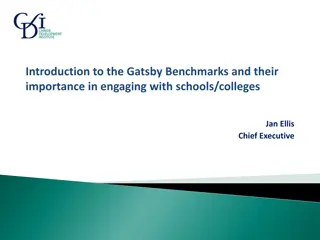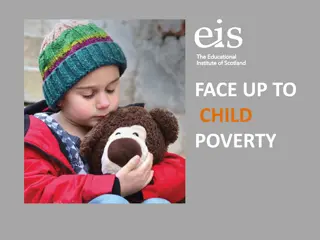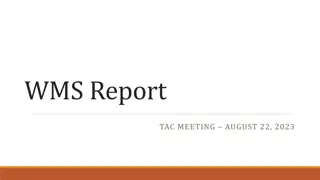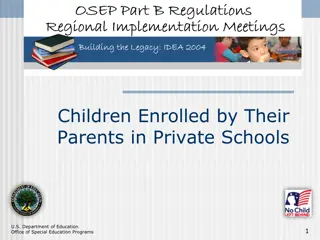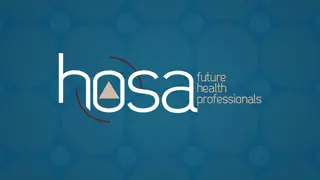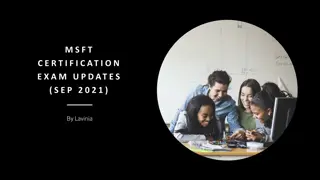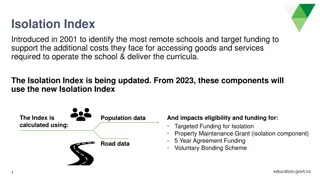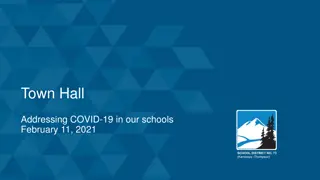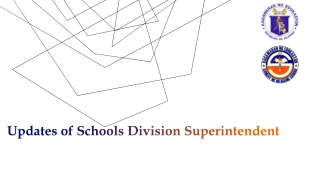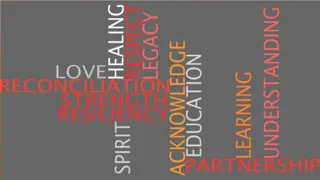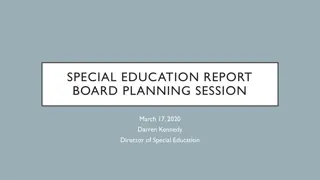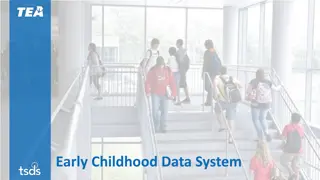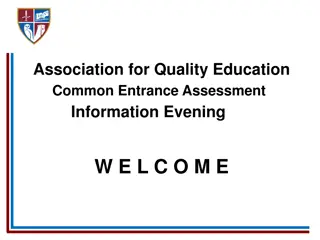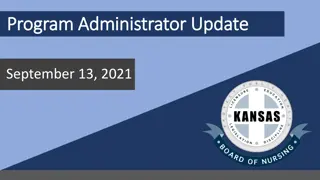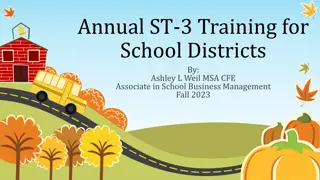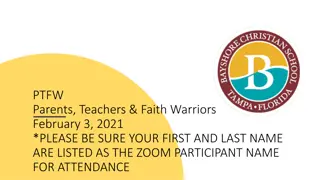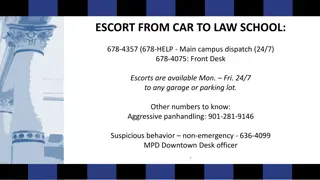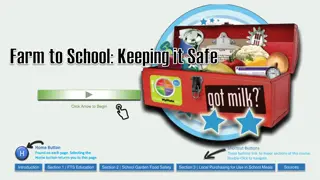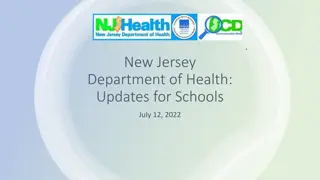September Guidance for Schools Overview: Latest Updates on School Reopening
Schools are expected to open for all pupils with measures in place to reduce the risk of COVID-19 transmission. Emphasis is on following guidance, maintaining hygiene, implementing preventive measures, and being prepared to respond to confirmed cases. The focus is on sensible, proportionate controls, preventing symptomatic individuals from coming to school, and monitoring the effectiveness of these measures.
Uploaded on Sep 20, 2024 | 0 Views
Download Presentation

Please find below an Image/Link to download the presentation.
The content on the website is provided AS IS for your information and personal use only. It may not be sold, licensed, or shared on other websites without obtaining consent from the author. Download presentation by click this link. If you encounter any issues during the download, it is possible that the publisher has removed the file from their server.
E N D
Presentation Transcript
September guidance for schools Overview (Latest update: 1 September)
September expectations All schools and education settings to open for all pupils All schools to follow DfE guidance and PHE system of controls to reduce risk of transmission Guidance on face coverings updated for secondary schools Some flexibility on implementation - informed judgements but no part-time provision or rotas Schools asked to keep pupils in class or year bubbles wherever possible but not at expense of accessing full curriculum Protective measures to be put in place - emphasis on regular cleaning and hygiene Schools to have clear systems for responding to confirmed cases of infection as advised by PHE and local authority Schools must be actively engaged with NHS Test and Trace Extra-curricular provision to resume
Controls sensible, proportionate controls Reduce risks of transmission reasonably practical Groups of children - class or year bubbles avoiding mixing where possible but not at expense of curriculum Avoid large groupings assemblies/concerts Seating plans forward-facing desks Staff distance from pupils and each other as much as possible Update risk assessments and monitor arrangements No touching where possible Staggered starts, breaks, lunch and finish if possible Regular and thorough cleaning avoid shared resources where feasible
Prevention, Response and Containing Outbreaks of Covid-19 Prevention All schools to follow DFE/PHE hierarchy of controls to reduce risk of spread: System in place for preventing symptomatic children and staff coming to school (must) Ensure that all parents are aware of symptoms and how to get tested Hand and respiratory hygiene (must) Enhanced cleaning (must) Reduce contacts and maximise distancing (properly considered) PPE and face coverings in (specific circumstances) Robust risk assessments System in place for monitoring effectiveness of above controls
Prevention, Response and Containing Outbreaks of Covid-19 (1) Face coverings update Please refer to recently published guidance on use of face coverings in education settings Key messages: Face coverings not routinely required in education settings Secondary schools may consider recommending use of face coverings in corridors/crowded spaces if social distancing cannot be maintained; not recommended for classroom Mandatory face coverings for secondary schools in corridors/crowded spaces when in a local lockdown area In addition, Ealing Council recommend: Schools to consider use of face coverings for staff and parents if there is any difficulty in social distancing between adults (teachers in meetings/staff room and parents during drop-off). It is vital that face coverings are worn correctly and that clear instructions are provided to staff, children and young people on how to put on, remove, store and dispose of face coverings in all of the circumstances above, to avoid inadvertently increasing the risks of transmission.
Prevention, Response and Containing Outbreaks of Covid-19 (2) Response Identification and management of possible and confirmed cases Use flowchart on EGFL This has been updated. Increased period of isolation for anyone with Covid symptoms from 7 to 10 days; no requirement to inform LA of symptomatic cases (only confirmed cases who test positive); taken out suggestion to inform parents if a symptomatic case in the class https://www.egfl.org.uk/coronavirus#testing Engage with the NHS Test and Trace process, including isolation of close contacts Department of Health has agreed to provide walk through test sites in Ealing -likely to be located in Southall, Northolt/Greenford and Acton. We will share further details once this is finalised- likely to set up throughout September. Containing outbreaks Work with Health Protection Team (London Coronavirus Response Cell, 0300 303 0450) and Local authority to determine actions publichealth@ealing.gov.uk. This will not change despite organisational changes in Public Health England Including need for isolation of larger groups of children If schools are effectively implementing the prevention controls, whole school closure will not generally be necessary, and should not be considered except on advice from health protection team Ealing infection rates Schools should note that the weekly infection rate is now published on the Ealing Council webpage https://www.ealing.gov.uk/coronavirus
Groupings Secondary bubbles the size of year groups (or smaller where possible) Keep apart from other groups where possible Small adaptations to classrooms and desks Teachers can operate across different groups Adults in secondary schools to try and keep 2m from others or limit closer contact No expectation of 2m with younger children or those with complex needs Avoid congestion where possible - pupils and adults
Curriculum and assessment (1) Broad and balanced curriculum for all modifications when necessary but full entitlement by Summer latest Use existing flexibilities to cover missed content Reinforce basics reading through all subjects Assess starting points and plan from there to address gaps in knowledge and skills Regular, formative assessment Full provision and support for SEND Support staff and additional services as usual Schools can suspend some subjects exceptional circumstances RHE and RSHE compulsory and expected by summer 2021 latest Can discontinue subjects for Y11 if necessary to support focus on core Review any plans for early entry Y10 Music singing, wind and brass precautions PE outdoors when and wherever possible cleaning indoors Emphasis on pastoral - pupil wellbeing and support
Curriculum and assessment (2) Primary statutory assessment will take place summer 2021 EYFS, KS1, KS2 usual timetable phonics screening; KS1 TA; Y4 multiplication; KS2 tests and TA; statutory trialling Reception baseline assessment postponed until Sept 21 Reviewing requirements re phonics screening check in Y2 GCSEs and A Levels scheduled Summer 21 with adaptations Opportunity for Autumn exams series funding announced No performance tables for 2019 to 2020 academic year
Accountability Ofsted Routine Section 5 and Section 8 inspections suspended for Autumn term From 28thSeptember, HMI face-to-face visits scheduled 5% of all schools - focus on management of pupils return; planned approach for maximising access to learning including blended approach; vulnerable pupils; wellbeing and behaviour as a whole - collaborative discussions with leaders (no lesson observations) - No judgements. Letter written on site with leaders. Safeguarding inspections continue as usual
GCSE, A Levels and vocational qualifications 2021 GCSE, A Levels and vocational qualifications 2021 (updated 19 2020) 2020) (updated 19th thAugust August Exams and assessments to go ahead for 2021 Changes announced to 15 A level subjects and 25 GCSE subjects (not all taken in Ealing ) 8 GCSE and 18 A level subjects taken in Ealing are not changing the method of assessment An outline of the changes can be found in this document: https://www.gov.uk/government/consultations/proposed-changes-to-the-assessment-of-gcses-as- and-a-levels-in-2021 - No significant changes to length or format of exam papers -Delay to exams no decision to date -Contingency plans in event of further disruption in progress -Flexibilities for vocational subject assessment consultation closes 14 August https://www.gov.uk/government/consultations/consultation-on-the-assessment-and-awarding-of- vocational-technical-and-other-general-qualifications-in-2020-to-2021
Examination results 2020 (updated 20th August 2020) The government announced on 17thAugust 2020 that students would receive their teacher assessed grades for A levels and GCSEs (unless the calculated grade from Ofqual is higher) https://www.gov.uk/government/news/gcse-and-a-level-students-to-receive- centre-assessment-grades On 19th August 2020 Pearson (provider of BTEC qualifications) announced they would re-issue grades as they had been affected by the grading algorithm. OCR already planned to re-issue grades. The new results are likely to be issued in week beginning 24th August 2020 30M Support package to help schools with costs of running re-sits in Autumn
Behaviour Focus on pupil and staff wellbeing Understand that behaviour is communication Employ your qualities and interpersonal skills, such as active listening, empathy and unconditional positive regard to understand behaviour (Treisman, 2017). Review and revise behaviour policy Usual powers but consider carefully . Plan for pupils who may be most anxious or reluctant to engage consider context and experiences - reintegration programmes/ Behaviour regulation plan Seek advice from relevant professionals e.g. Ealing Primary Centre, Behaviour and Inclusion Service (BIS) and the Educational Psychology Service. Please see the Educational Psychology Service Document- Advice for Schools: Transition back to school
SEND Pupils in mainstream All children are expected to start back in provision from September and EHCP are recognised as being particularly vulnerable when not attending school. The government intends to reinstate Section 42 so that reasonable endeavours no longer apply and all provision should be made available by schools. Specific support needs to be put in place for children with an EHCP and in some cases a transition plan discussed and coproduced with parents/carers to ensure a successful transition back to school. The statutory duties on schools under the equalities legislation remain in place and children with an EHCP having a protected characteristic will have special rights which need to be considered. Behaviour policies should not discriminate unfairly against children with an EHCP who by the nature of their needs may find it difficult to socially distance, may spit or behave in other challenging ways and these types of behaviours should be anticipated within return to school planning. Please see the Educational Psychology Service document- Advice for Schools: Transition back to school
Special Schools The expectations on special schools are very similar to mainstream settings including remote learning for those who must not attend school Co-production and involvement of families and young people expected Expect full return to start in Autumn Term, should not be rotas Attendance compulsory unless specific exceptions apply detailed in the document DfE does not intend to issue any further notices to modify EHC duties in respect of using reasonable endeavours to provide what is specified in plans. Current one expires 31st July
Special Schools and other specialist settings (1) There will be no further national notices issued to modify the EHC duties, but consideration will be given to whether any such flexibilities may be required locally to respond to outbreaks. All children back to school full time from the start of the autumn term Provision of a full educational experience for pupils Plan for the possibility of a local lockdown to ensure continuity of education Risk assessments may prove useful now and over the autumn term, in identifying what additional support children and young people with EHC plans need to make a successful return to full education Review health and safety risk assessments and draw up plans for the autumn term that address the risks identified Specialist therapists, clinicians and other support staff for pupils with SEND should provide interventions as usual and can move between settings
Special Schools and other specialist settings (2) Classroom based resources can be shared between a bubble, they should be cleaned regularly along with all frequently touched surfaces Resources that are shared between classes or bubbles, such as sports, art and science equipment should be cleaned frequently and meticulously and always between bubbles, or rotated to allow them to be left unused for a period of 48 hours (72 hours for plastics) between use by different bubbles. Settings will need to make an assessment of the cleanability of equipment used in the delivery of therapies (for example. physiotherapy equipment, sensory equipment), to determine whether this equipment can withstand cleaning and disinfection between each use (and how easy or practical it would be to do so) before it is put back into general use. Where cleaning or disinfection is not possible or practical, resources will have to be restricted to one user, or be left unused for a period of 48 hours (72 hours for plastics) between use by different individuals.
Risk Assessments Revised risk assessments required, LA has updated the generic risk assessment https://www.egfl.org.uk/coronavirus Focus on sensible and proportionate control measures Consultation with representatives of staff required in good time Consider involving parents and pupils, may help to reassure them regarding steps you are taking HSE expect Assessment to be published for employers with more than 50 employees Monitor and review the preventive and protective measures regularly
Staffing guidance updated Workforce in Schools Sept 2020 Guidance states that most staff expected to be back at school from Sept. Please note references in brackets below refer to those cateogries of staff in Ealing s guidance on school workforce Staff in the most at risk categories may be able to return but... flexibility in how these staff are deployed and extra care taken to ensure safety e.g. individual risk assessment Cross reference of advice for clinically vulnerable and clinically extremely vulnerable (Ealing category 6) Discussion with individuals is encouraged to identify concerns/anxieties and establish if these can be mitigated to the extent necessary to bring staff back Reference also to circumstances that may lead to reintroduction of shielding Self-isolation period for those displaying C19 symptoms has changed from 7 to 10 days (Ealing categories 1 & 3) Staff reluctant to attend school or those who may be at increased risk from C19 (Ealing category 12) New category for staff who are pregnant two risk assessments required (Ealing new category 10) New category for staff having to self isolate after travel abroad (Ealing new category 14) Emphasis of legal obligations on health and safety Employers reminded of need to pay due regard to staff wellbeing and work-life balance Supply teachers and peripatetic staff can move between schools Specialist and therapists business as usual https://www.gov.uk/government/publications/actions-for-schools-during-the-coronavirus-outbreak/guidance-for-full-opening-schools https://www.egfl.org.uk/coronavirus
Attendance Mandatory, Parents duty to secure that their child attends regularly at their education setting where the child is a registered pupil at school and they are of compulsory school age. As attendance will be mandatory the LA advises school maintain usual term dates and not to plan increases in the number of inset days beyond the usual 5, or extended the summer closure period unless this is unavoidable or can be made up. Usual school processes apply in determining and changing dates with the LA published term dates. Refer to the School Attendance Team if there are attendance concerns or the child does not return to school. Early work with parents and families who have concerns about return. Work with LA in anticipating persistent absence Settings responsibilities to record attendance and follow up absence Availability to issue sanctions, including fixed penalty notices in line with local authorities codes of conduct; There will be a phased re-introduction of fines, please view EGFL link below for further information Under usual circumstances schools must meet for at least 380 sessions or 190 days during any school year to educate their pupils. If a school is prevented from meeting for one or more sessions because of an unavoidable event, it should find a practical way of holding extrasessions. If it cannot find a practical way of doing this then it is not required to make up the lost sessions. Daily return to DfE via Educational settings status form; the form should be completed by midday every working day. View link below Relevant guidance: DFE school attendance guidance Ealing school attendance guidance and example school attendance policy DfE daily return
Transport Special school transport Dedicated transport will be a bubble in itself. Social distancing not a requirement, other additional protective measures to continue, working with individual schools to plan for September. Transport staff will wear face coverings. Public transport limited capacity and social distancing remains 2m and 1m+. Passengers encouraged to walk and cycle. Face coverings to be worn by those over 11. Guidance on safe travel Guidance on travel to school cycling, walking, scooting and using public transport safely Spreadsheet of dedicated TFL Ealing school bus services at 26/8 NB information will be reviewed and updated so users are advised to check TFL website regularly for changes
National back to school and TfL activetravel resources Support families to plan an active, safe and socially distanced journey: PHE hub resources including leaflets in community languages DFE videos for parents/ carers including on travel DFE social media posts using #backtoschoolsafely Dept of Transport resources - return to school script and posters TFL Journey Planner TFL video TFL Go app (new - Apple devices only initially) - includes walking/ cycling options to consider TFL STARS Safer Journey Planner (new) advice on save travel to school, plus resources and a community project with schools Online cycle skills course plus tips on preparing your bike for the road
Transport free travel Awaiting further guidance: temporary suspension of free travel for 11-17-year olds, planned to be implemented immediately after October half term. This is ambitious Remaining eligible for free travel are: children aged 10 and under, children aged 11-17 who live more than two miles walking distance from their school/college, and Children aged 11-17 who live less than two miles walking distance from their school/college if they: have a social worker have an Education, Health and Care Plan are in alternative provision (i.e. educated in a pupil referral unit, or an alternative provision academy/free school) do not have a safe walking route under two miles walking distance cannot walk due to a medical condition or lack of mobility The eligibility criteria set out above will apply until the end of the academic year in which a child turns 11 or 18.
Contingency Arrangements Remote learning Government expects schools to have the capacity to offer immediate high quality remote education, where a class, group or small number of pupils need to self-isolate, or there is a local lockdown Expect schools to have strong contingency plan in place for remote education provision by the end of September Government will explore making a temporary continuity direction in the autumn term, to give additional clarity as to what remote education should be provided. Advice and guidance on remote learning
Contingency Arrangements in the event of local restrictions Key principles ensure continuity of education in exceptional circumstances key aim to retain as much face-to-face education and access to childcare as possible extensive limitations on education and childcare are a last resort priority is given to vulnerable children and children of critical workers for face-to-face provision in all cases
Contingency Arrangements Tiers of restrictions Tier 1 requirement : Schools remain fully open but there is a requirement that face coverings should be worn by staff and students in schools and colleges, from year 7 and above, outside classrooms when moving around communal areas where social distancing cannot easily be maintained Tier 2 requirement : Secondary schools adopt a rota system and further education (FE) colleges to limit on-site attendance, whilst all other settings, including alternative provision (AP) and special schools, remain fully open. Tier 3 requirement : Secondary schools and FE colleges limit on-site attendance to just vulnerable children and young people, the children of critical workers and selected year groups. Other settings remain open. Department for Education will issue operational guidance for the affected area to confirm which year groups should be prioritised. Tier 4 requirement: Attendance limited to just vulnerable children and young people and the children of critical workers at all settings, excluding AP and special schools. N.B Where there are no local restrictions in place, education provision should continue to remain fully open to all, and these tiers do not apply.
Contingency Arrangements Tier 2 detailed overview Tier 2 rota systems for secondary-aged pupils in mainstream settings only if necessary Full-time on-site provision should remain available for all vulnerable children and young people, who are expected to attend full-time, and for the children of critical workers who require this. A rota system to limit the number of pupils on-site at any one time and break transmission chains within schools when scheduled time at home is long enough for the onset of symptoms to be detected before returning. Schools should ideally operate a rota system that means pupils spend 2 weeks on-site followed by 2 weeks at home However, schools can choose to operate a one-week rota (so, 5 days on-site, followed by 9 days at home) if this is necessary for the effective delivery of the curriculum. Rota lengths should not be any shorter than one week as this does not provide sufficient time off-site for symptoms to present. Schools should plan to utilise time over the weekend effectively in order to prepare for a different rota group at the start of the week. It is for schools to decide how best to split their pupils into 2 distinct rota groups Different rota groups can use the same classrooms and facilities. Schools should ensure cleaning of frequently touched surfaces takes place in between use by different rota groups, in addition to enhanced cleaning arrangements already in place. Shared resources should also be cleaned frequently but to note, for non-plastics 48 hours (over a weekend) is sufficient time to leave between use by different groups Vulnerable children/ young people and children of critical workers should be integrated into rota groups, even if they continue to remain on-site during weeks their rota group is scheduled to be at home There is no fixed percentage of pupils on-site that schools should not exceed. https://www.gov.uk/government/publications/how-schools-can-plan-for-tier-2-local-restrictions
Access to IT and resources (in addition to DFE devices distributed May July 2020 to children with social workers and disadvantaged Y10s) Schools can apply for government-funded support through The Key for School Leaders and access one of two free-to-use digital education platforms: G Suite for Education or Office 365 Education; info on the EdTech Demonstrator Programme More laptops and tablets will be made available for disadvantaged children in certain year groups who are affected by disruption to face to face education at their school, or have been advised to shield. Further guidance awaited local authorities to provide school-nominated contacts for ordering from DFE, delivery within 2 days; devices will be owned by school and can be loaned to students; before distributing schools should set up devices for access to remote education and ensure appropriate safeguarding controls and support are in place. Pilot schemes to increase access to internet in progress
Catch-up premium 2020 - 2021 School allocations on per pupil basis 80 for each pupil Reception to Y11 Special and AP schools provided with 240 per place with additional weighting for specialist settings Funding provided in three tranches Flexibility in how funds are used (see Education Endowment Fund support guide for schools on evidence based approaches) https://educationendowmentfoundation.org.uk/covid-19-resources/covid- 19-support-guide-for-schools/#nav-covid-19-support-guide-for-schools1
National Tutoring Programme 2020 - 2021 Programmes funded to be delivered in Autumn onwards High-quality tuition available to 5 to 16 year olds in state-funded primary and secondary schools - delivery led by EEF 16 to 19 fund for school sixth forms, colleges and all other 16 to 19 providers to provide small group tutoring activity for disadvantaged Teach First tasked with recruiting, training and placing Academic Mentors (salaries subsidised by government) Tuition Partners Academic Mentors Schools to express their interest in participating in or contributing directly to the programmes at websites above. Funding round opens 31st August
After-school clubs, holiday & other out of school settings (OOSS) Protective measures to enable providers to open for both outdoor and indoor provision updated for Sept 20 encouraging children to walk/ cycle/ travel by private vehicle rather than taking public transport. Children should not car share with anyone outside their household (or bubble). Guidance on protective measures for different types of premises, need for risk assessment, outdoor provision where feasible, controls measures as for schools for indoor provision, sports/ gym/ leisure facility guidance, in-home guidance. Communicating safe working measures with staff and parents; safeguarding and wellbeing measures; equality considerations Music, dance, drama singing, wind and brass teaching subject to measures to mitigate aerosol transmission (ventilation, distancing, positioning, no shouting/ singing loudly Bubbles of up to 15, minimise mixing, record keeping for Test and Trace. Process for removing face coverings on arrival. Infection protection system of controls for public/ community settings. No overnight or residential provision. Non-overnight educational visits allowed, subject to bubbles; Covid secure travel arrangements and risk assessments Shared resources regular cleaning, avoid unnecessary sharing Protective measures - provider guidance, Protective measures parent carer guidance
Full guidance Guidance for full opening schools Guidance for full opening-special-schools-and-other-specialist-settings Advice for schools and childcare settings during the coronavirus (COVID- 19) outbreak, including operating guidance, emergency contacts and plans for reopening on Ealing Grid for Learning


